GIGABYTE BRIX Pro: A First Look at the Intel i7-4770R with Iris Pro HD 5200
by Ganesh T S on January 7, 2014 8:00 PM EST
Gigabyte is targeting the BRIX Pro towards professional consumers with compute-intensive workloads. For general office use (including web browsing and light word processing work), systems such as the Core i5-based NUC we reviewed last week are more than enough. In order to bring out scenarios where the extra grunt provided by the Pro unit becomes necessary, we are presenting some real world benchmarks below. These are tasks carried out by workers where time in money, and the premium paid upfront for the better configuration is trivial compared to the time saved.
WinRAR Benchmark
We present two benchmarks using WinRAR. The first one involves decompressing a 4.36 GB split archive and recording the time taken to complete the process. This is a test of the CPU power as well as the storage subsystem.
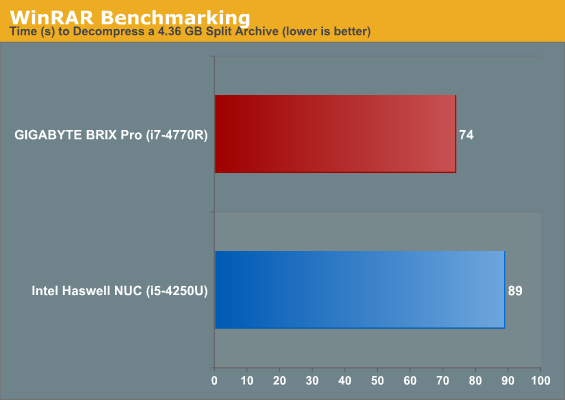
The graph below presents the internal WinRAR benchmark numbers. In this benchmark, the program takes compresses / decompresses random data in the RAM. This is a test of the CPU power as well as the DRAM capabilities.
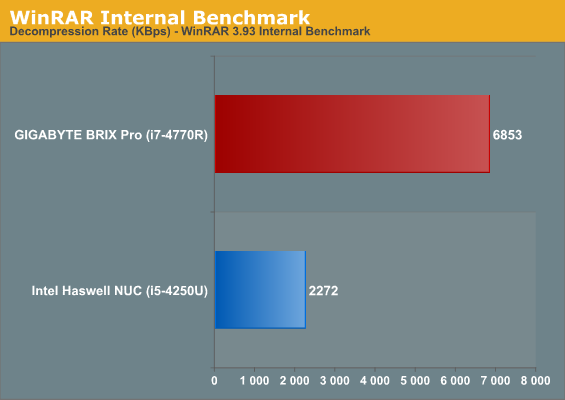
TrueCrypt Benchmark
As businesses (and even home consumers) become more security conscious, the importance of encryption can't be overstated. CPUs supporting the AES-NI instruction for accelerating the encryption and decryption processes have, till now, been the higher end SKUs. However, with Bay Trail, even the lowly Atom series has gained support for AES-NI. Both the i5-4250U and the i7-4770R have AES-NI instructions support. The TrueCrypt internal benchmark provides some interesting cryptography-related numbers to ponder. In the graph below, we can get an idea of how fast a TrueCrypt volume would behave in the two different systems.
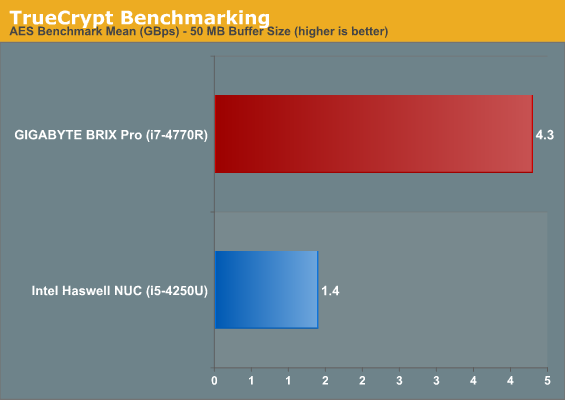
Agisoft PhotoScan
Agisoft PhotoScan is a commercial program that converts 2D images into 3D point maps, meshes and textures. The program designers sent us a command line version in order to evaluate the efficiency of various systems that go under our review scanner. The command line version has two benchmark modes, one using the CPU and the other using both the CPU and GPU (via OpenCL). The benchmark takes around 50 photographs and does four stages of computation:
Stage 1: Align Photographs
Stage 2: Build Point Cloud (capable of OpenCL acceleration)
Stage 3: Build Mesh
Stage 4: Build Textures
We record the time taken for each stage. Since various elements of the software are single threaded, others multithreaded, and some use GPUs, it is interesting to record the effects of CPU generations, speeds, number of cores, DRAM parameters and the GPU using this software.
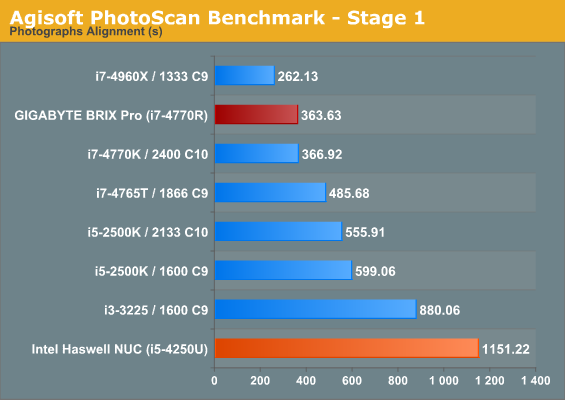
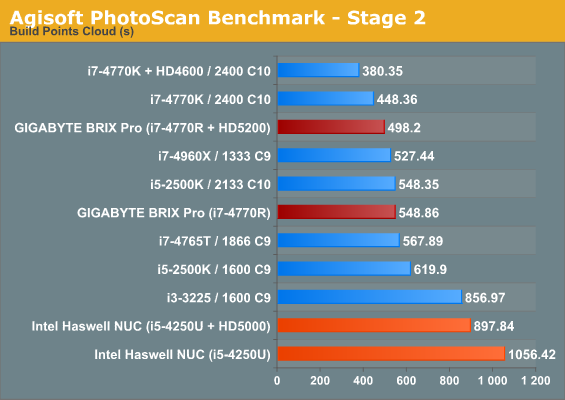

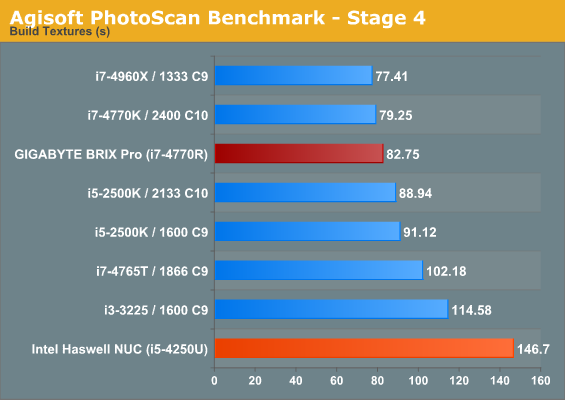
The second stage also reports the throughput rate of the CPU and GPU in million points per second. For the BRIX Pro, in the CPU only mode, we had a rate of 124.99 mp/s. Using OpenCL acceleration, the CPU and GPU had rates of 69.5 mp/s and 98.32 mp/s respectively. The corresponding numbers for the NUC were 68.36 mp/s, 20.39 mp/s and 78.59 mp/s.
Essentially a prosumer real-world test, we hope to put more of our systems under this benchmark in the future. Ian already has a large number of custom-built systems for which he will present benchmarks in his motherboard reviews.










98 Comments
View All Comments
kgh00007 - Friday, January 31, 2014 - link
Come on its been 3 weeks now, us this going to be like the Galaxy S4 where part two of the review just never happened?ryrynz - Saturday, February 1, 2014 - link
Taking far too long to get this second bit out. One word. SLACK.kgh00007 - Tuesday, February 4, 2014 - link
Hi, if you are still testing this system, could you please check if Hyperthreading can be switched off in the BIOS? Cheers!AngryCorgi - Saturday, February 8, 2014 - link
The reviewer ponders the logic of maybe using the 4950hq cpu instead. The problem being that the 4950hq retails at roughly twice the cost of the 4770r. So, no, I don't think that would make sense. Anandtech needs to review the new brix 8890 with dedicated R9 m275x GPU as soon as it's available. That could be a far wiser direction for gamers and potential steam box usage.funtasticguy - Monday, February 10, 2014 - link
When is the rest of the review coming? I have been eagerly anticipating the second half since early January.Antronman - Tuesday, February 11, 2014 - link
Still more expensive than configuring a better PC build, that runs way quieter. When I say better, I mean better performance in videogames, as I could include a pretty good GPU for the same price. http://pcpartpicker.com/p/2RH3z <- the only reason it is more expensive is because it includes the cost of the OS and a CPU cooler. Factor that out, and you get a much better machine. CPU computing power equal to an i5 for 50USD less, OC capability with the H100i. Wayy better graphics that can run almost every modern game with the exception of a small handful (not BF4) on max settings at 60+ fps. Only disadvantage is the lack of an SSD.ryrynz - Saturday, February 15, 2014 - link
Thing is you can't factor those things out, its oart of the build. The great thing about this is portability.. the size for the performance is phenomenal. You don't need to splash out on a good cooler (though you might have to to get the nosie down...) No PSU.. No case. I'd actually save money buying one of these over the usual upgrade.. but it's noisy.. so meh.Gigabyte dropped the ball, they should have given this a silent option.
alpha754293 - Monday, June 16, 2014 - link
I'm using a Mac Mini to drive my 55" TV right now and it works REALLY, REALLY well. And as HTPC system, other than I can't do BluRay (which I've been told that there are workarounds for that) - it's cheaper and smaller and consumes less power than these systems.